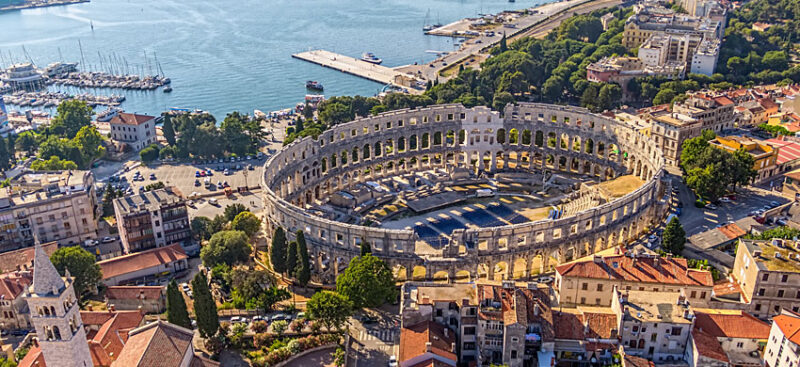
The Pula Amphitheatre: Croatia’s Hidden Gem
Croatia, home to the famed Roman arena Pula, offers more than just the world’s most beautiful beaches. Beyond its pristine nature, jaw-dropping landscapes, and memorable music festivals, the country takes pride in significant landmarks. One of the most notable is the Pula Arena, a testament to Pula Arena’s history.
Dating back to the 1st century AD, the Pula Arena is a Roman Amphitheatre that stands proudly in Pula, the heart of the Istria region on the Mediterranean coast. Brace yourself as we delve deep into the origins, history, myths, legends, and Pula Arena facts that make this Amphitheatre a must-visit.
Pula Arena History: From Timber Beginnings to Limestone Grandeur
Back when the Amphitheatre Pula was constructed, the Balkan region was a jewel in the crown of the Roman Empire. This empire, responsible for creating major cities in today’s Croatia, including Pula, was the force behind the inception of this arena.
Originally, the arena was crafted from timber during the reign of Emperor Augustus, a time when Pula was blossoming as a pivotal administrative centre. It wasn’t until Emperor Vespasian, renowned for various Vespasian facts, took charge that the arena transformed. Using local limestone, the Amphitheatre expanded its capacity, creating a space for thrilling gladiatorial games.
With the ability to house over 20,000 exuberant spectators, the Pula Amphitheatre was a site of fierce battles. Gladiators, many being slaves or condemned criminals, clashed in deadly duels either to establish dominance or to win their prized freedom.
An intriguing Pula Arena fact is that the Amphitheatre has retained most of its original structure through the ages. Notably, it’s the sole Roman Amphitheatre with four intact side towers and stands as the sixth largest of its kind globally.
Amphitheatre Pula Myths: From Gladiator Gestures to Fairytales
The Amphitheatre Pula has been a breeding ground for numerous myths and legends. A widely accepted myth is that the outcome of a gladiator’s battle was dictated by thumb gestures. Contrary to popular movie depictions, some historians assert that a thumb-down gesture signified ‘swords down‘, sparing the fallen gladiator.
Another fascinating legend credits Vespasian with constructing the arena as a homage to his local beloved. Yet, local tales speak of fairies building the Amphitheatre under the cover of night, leaving it roofless at dawn to remain undetected.
Pula Amphitheatre Today: Concerts, Festivals, and More
The Pula Amphitheatre in its current state serves as an iconic backdrop for world-class concerts and events. Giants of the music industry, from Luciano Pavarotti to David Gilmour, have graced this stage. Besides concerts, the Amphitheatre Pula tickets allow attendees to immerse in a renowned film festival held annually. Additionally, during summertime, spectators can relive the Roman era with the Spectacvla Antiqva, a vivid reenactment of gladiatorial combats.
Prices: adult tickets are 10 eur (75,35 kn), students and children (between 6 and 18) tickets are 5 eur (37,67 kn); therefore children up to 5 years get in for free.
Opening Hours:
January: 9:00 a.m. — 5 p.m.
February: 9:00 a.m. — 5 p.m.
March: 9:00 a.m. — 5 p.m.
April: 8:00 a.m. — 8 p.m.
May: 8:00 a.m. — 9 p.m.
June: 8:00 a.m. — 10 p.m.
July: 8:00 a.m. — 10 p.m.
August: 8:00 a.m. — 10 p.m.
September: 8:00 a.m. — 9 p.m.
October: 8:00 a.m. — 8 p.m.
November: 9:00 a.m. — 5 p.m.
December: 9:00 a.m. — 5 p.m.
Who Built the Pula Arena?
The initial construction of the Pula Arena began under Emperor Augustus using timber. Later, during the reign of Emperor Vespasian, it underwent major renovations, transitioning from timber to limestone and expanding its grandeur.
How Big is the Pula Arena?
This magnificent structure could accommodate over 20,000 spectators in its prime, making it one of the largest Roman Amphitheatres. Its reputation is further cemented as it’s the sixth-largest surviving Amphitheatre worldwide.
A journey from Venice and Istria to Pula with Venezia Lines
Nestled within Croatia’s rich tapestry of attractions lies the iconic Roman Arena Pula. If Venice or Istria marks the beginning of your voyage, let Venezia Lines ferries seamlessly guide you to Pula’s shores. Whether it’s to marvel at the arena or to partake in its vibrant events, your journey becomes simpler with us.
An increasing tribe of travellers trusts our ferries to bridge the gap between Venice and the captivating Croatian coastline. By entrusting us with your journey, you’re ensuring a smooth sail to Pula, a gateway to myriad Croatian wonders.
Enhance your Croatian escapade with our alluring packages, tailored for both families and groups. Or, step up the luxury by joining our VIP Club, designed to transform your Croatian vacation into an experience of a lifetime.
